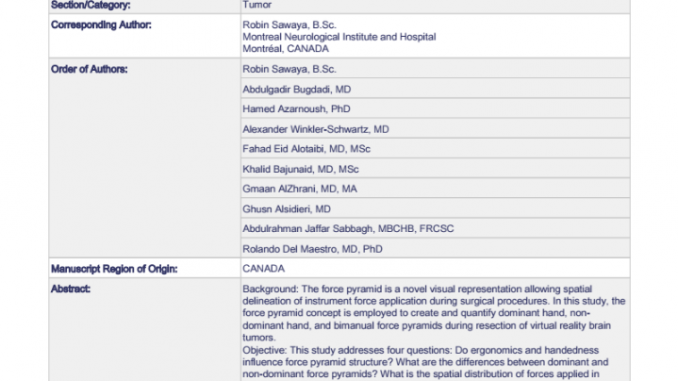
Accepted in Operative Neurosurgery, Jul 26 2017
Robin Sawaya, B.Sc. Abdulgadir Bugdadi, MD. Hamed Azarnoush, PhD. Alexander Winkler-Schwartz, MD. Fahad Eid Alotaibi, MD, MSc. Khalid Bajunaid, MD, MSc. Gmaan AlZhrani, MD, MA. Ghusn Alsidieri, MD. Abdulrahman Jaffar Sabbagh, MBCHB, FRCSC. Rolando Del Maestro, MD, PhD
Abstract
Background: The force pyramid is a novel visual representation allowing spatial delineation of instrument force application during surgical procedures. In this study, the force pyramid concept is employed to create and quantify dominant hand, non-dominant hand, and bimanual force pyramids during resection of virtual reality brain tumors.
Objective: This study addresses four questions: Do ergonomics and handedness influence force pyramid structure? What are the differences between dominant and non-dominant force pyramids? What is the spatial distribution of forces applied in specific tumor quadrants? What differentiates ‘expert’ and ‘novice’ groups regarding their force pyramids?
Methods: Using a simulated aspirator in the dominant hand and a simulated sucker in the non-dominant hand, 6 neurosurgeons and 14 residents resected 8 different tumors using the NeuroVR virtual reality neurosurgical simulation platform. Position and force data were used to create force pyramids and quantify tumor quadrant force distribution.
Results: Force distribution quantification demonstrates the critical role that handedness and ergonomics play on psychomotor performance during simulated brain tumor resections. Neurosurgeons concentrate their dominant hand forces in a defined crescent in the lower-right tumor quadrant. Non-dominant force pyramids showed a central peak force application in all groups. Bimanual force pyramids outlined the combined impact of each hand. Distinct force pyramid patterns were seen when tumor stiffness, border complexity, and color were altered.
Conclusion: Force pyramids allow delineation of specific tumor regions requiring greater psychomotor ability to resect. This information can focus and improve resident technical skills training.
